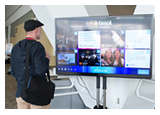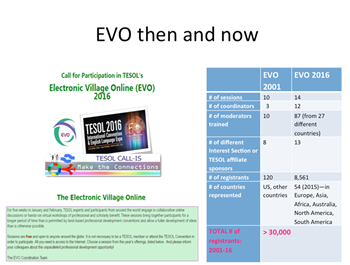|
 Another year, another TESOL convention—however, this year marks the 50th anniversary of the organization and is therefore a special one. Today, we take TESOL for granted: It provides leadership in our professional field, creates professional standards, conducts research, publishes relevant books and social media posts, takes an active role in politics, and builds bridges around the world for English learners and teachers. What began 50 years ago as an organization communicating by way of books, newsletters, and mail has developed into a high-tech global presence. Another year, another TESOL convention—however, this year marks the 50th anniversary of the organization and is therefore a special one. Today, we take TESOL for granted: It provides leadership in our professional field, creates professional standards, conducts research, publishes relevant books and social media posts, takes an active role in politics, and builds bridges around the world for English learners and teachers. What began 50 years ago as an organization communicating by way of books, newsletters, and mail has developed into a high-tech global presence.
TESOL is present at all relevant social media platforms. There is the TESOL Blog and a collection of digitally archived and available training sessions. And yes, there is an app for it. TESOL’s convention app is a useful tool for visitors to navigate the convention, find rooms, and put together their personal session itinerary for the convention.
TESOL members can stay abreast of the activities of the executive director, president, and board members via social media. TESOL leaders are extremely accessible to the public, answering questions and listening to suggestions in an instant way. Technology has enabled TESOL to connect association leaders directly to the membership and the public. Such instant access revolutionizes the real-time and real-life awareness of leaders who can react to the needs of the membership in much more pointed ways. Because of the leaders’ social media presence, members find it much easier to approach them in person at the annual convention.
Also, over the past years, TESOL has been making use of technology by conducting regular member surveys and encouraging emerging leaders to step forward and assume more active roles, which is apparent at the convention and during networking.
The Computer-Assisted Language Learning Interest Section
The remarkable 50-year TESOL anniversary is also a good occasion to reflect upon the role that technology plays for language learning and teaching. What began many years ago as the interest of some obscure techies and Webheads at the sidelines of previous conventions developed into the Computer-Assisted Language Learning (CALL) Interest Section (IS), founded in 1984. Since then, CALL-IS has become an essential part of professional development within TESOL International Association.
Over the years, CALL-IS has also become one of the major contributors to the success of the annual conventions. The important role of CALL-IS is already apparent for convention attendees upon check-in, when they receive two program books: one for the convention and expo, and another for the Electronic Village and Technology Showcase (pdf).
CALL works hard to offer convention visitors the best training possible. Its members put together The Electronic Village (EV) and the Technology Showcase. Here are a few session titles from this year’s program:
- Promoting Vocabulary Learning Through Online Resources
- Enhancing Speaking and Listening Through Skype and Facebook: A Multicultural Experience
- Using Apps to Customize and Assess Word Study
- Using Collaborative Tools in ESL Classrooms
- Strategies for Game-Based Writing Activities: Flipping Your Class With Web Browser Games
And there are plenty of sessions focusing on the use of specific apps and online tools. Here are just a few:
- SoundCloud Digital Portfolios for Improving Pronunciation
- Teaching With Turnitin
- Google Forms for Homework and Data Collection
- WhatsApp as a Learning Tool
- Brain Breaks, Fun and Learning With GoNoodle!
Session proposals for the EV and Technology Showcase are not pooled with the general session review process. All submitted session proposals are reviewed by CALL specialists, which assures the highest quality of CALL presentations.
Also, the CALL-IS also features a webcast recording service. During the convention, CALL-IS members volunteer their time to record interesting sessions. Such recordings are streamed live to a worldwide audience, which can ask questions of the presenters in real time. Also, the recordings are available to TESOL members after the conclusion of the convention as learning tutorials. Here are some of the CALL-IS sessions recorded at the 2016 convention:
- Project-Based Learning: Pedagogical Possibilities for Online, Mobile, and Blended Learning
- Creating, Adapting, and Using Content for Mobile Apps
- Flipping the Classroom: CALL in K-12
- Innovating Language Learning through Technology for Environmental Responsibility
- Leadership Panel: History of the EV Retrospective: Over Three Decades of Professional Development
- Online Assessment: How Important & Effective Is It?
- Meaningful Play: Gaming and Language Learning
Webcast recordings for the above-listed sessions are available on the CALL-IS wiki. The 2016 TESOL convention also marks the 10-year anniversary of webcasts conducted by the CALL-IS.
TESOL 2016: What Are The Electronic Village and Technology Showcase?
The Technology Showcase is a physical space where CALL-IS organizes events. It consists of meeting rooms for sessions where the latest and most cutting-edge topics are presented. CALL-IS’s large events, such as Hot Topics sessions and the CALL-IS academic session are all held in the same room throughout the convention. Having one large room for all events makes it convenient for attendees to find their way and make it to sessions fast.
The Electronic Village is a large meeting room transformed into a high-tech learning environment by creating clusters of computer stations for small groups of presenters and collaborators. Crowded with visitors from the first to the last minute of the convention, this room is where the real magic happens.
Hands-on learners from around the world collaborate with presenters and each other and learn how to be more skilled technology users. Many languages can be heard and many cultures can be seen. It is inspiring to observe entire groups of representatives from other countries learn together and acquire skills, which they then take back to their countries and share at their national affiliate conferences.
From the opening of the TESOL convention until the end, this room is buzzing with activity. Without attending a session, convention attendees with tech questions can stroll in and always find CALL-IS volunteers with ready answers and information on good training choices. The great networking culture of the EV goes back to 1986, when the EV was conceptualized as a hospitality room at the Anaheim TESOL convention. At the 1988 convention in Chicago, computers were added to the hospitality room. Soon after, software lists were shared with members who could try out new tools in a commercial-free environment. At the 1997 convention in Orlando, the term “hospitality room” was changed into the term “Electronic Village.” The EV has developed over the years into a meeting place for professionals to learn, share, and network. Here is a short snapshot of the history from a presentation by Christine Bauer-Ramazani at the 2016 TESOL convention:

Most TESOL attendees cannot imagine the annual convention without the EV and Technology Showcase. They embody TESOL’s mission of bringing together ELT and ESL professionals from all over the world to join in learning, sharing, and networking. Emerging leaders find opportunities to volunteer and to contribute to the organization. The recorded sessions provide digital professional development to the TESOL membership for years to come.
TESOL’s low-tech beginnings 50 years ago have developed into a robust system of technology that is utilized to strengthen the organization in all aspects. Members celebrate TESOL’s 50-year anniversary knowing that the organization is forging ahead stronger than ever.
References
Stevens, V. (2015, September). How the TESOL CALL interest section began (updated). On CALL. Retrieved from http://newsmanager.commpartners.com/tesolcallis/issues/2015-08-25/1.html
Liakos, N. (2016, March). All aboard for the Electronic Village…online! On CALL. Retrieved from http://newsmanager.commpartners.com/tesolcallis/issues/2016-03-01/7.html
Bauer-Ramazani, C. (2016). Leadership panel—History of the EV in retrospective: Over three decades of professional development in CALL. TESOL International Convention & English Language Expo, Baltimore, MD, April 5–8. Retrieved from http://callis2016.pbworks.com/w/page/104238963/TESOL%2050th%20Anniversary%20Special%20Event
Dr. Christel Broady is a professor of graduate education and ESL teacher education at Georgetown College, past president of the Kentucky TESOL, former chair of the TESOL EEIS, and current VDMIS steering board member. Christel is a specialist for CALL, an NCATE program reviewer, she also represented TESOL at CAEP and on the national workgroup for the Seal of Bilinguality in K–12 schools. She is the manager of “Broadyesl,” a worldwide ELT Community of Practice on Facebook, Wordpress (ESL and technology), LinkedIn, and Twitter. |